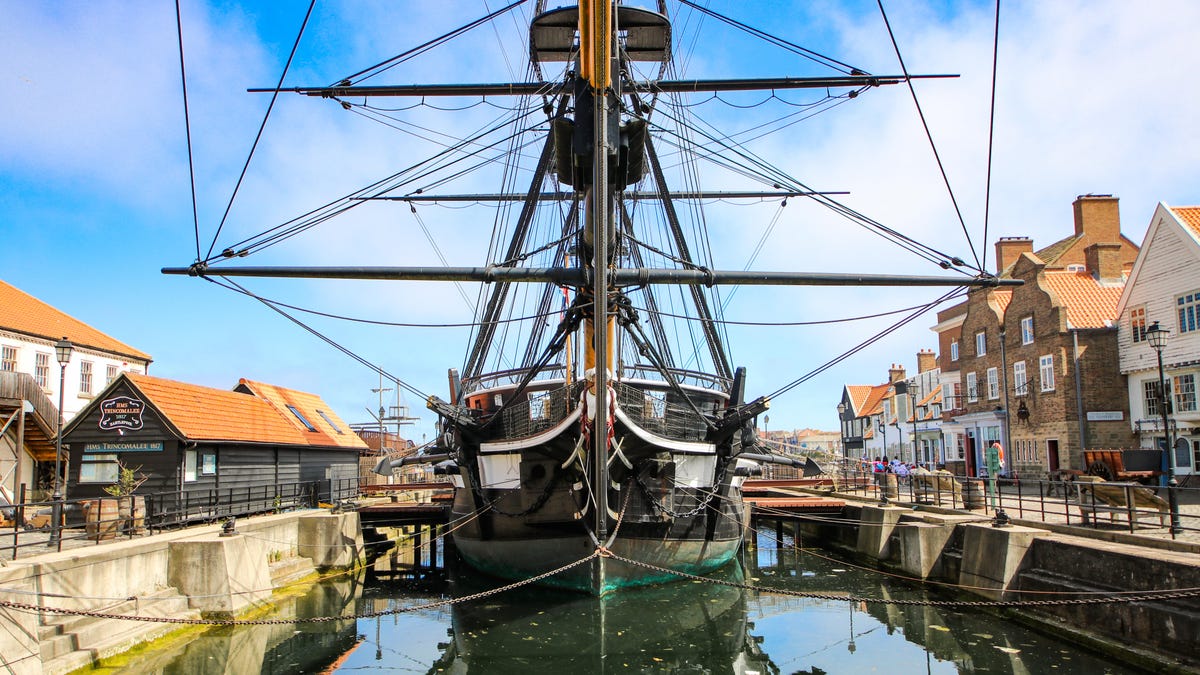 Why You Can Trust CNET
Why You Can Trust CNET 200 years of sails and teak: Touring Britain's HMS Trincomalee
Built in India in 1817, the Trincomalee sailed and served all over the world. Here’s a look from stem to stern.

It's odd, seeing the masts in the distance. Three of them, their rigging just visible, extend above the surrounding buildings. Hartlepool, in the northeast of England, might be a port town, but the few sails here are of the single-mast sailboat variety. The HMS Trincomalee is an imposing frigate from a different age.
Launched in 1817, she served the Royal Navy in various roles for 80 years, resuming a training role during WWII. She's the oldest British ship still afloat, with the older HMS Victory in dry dock.
In a unique twist, the area around the Trincomalee has been done up to look like what a port would have looked like in her day, complete with mannequins in costume and 19th century stores all around the quay.
It's a great museum and ship, in a rather unvisited corner of the UK. Here's how it looks up close and below decks.
A frigate of teak
The Trincomalee, named for the city in what is now Sri Lanka, is a Leda-class frigate, one of 47 built between 1800 and 1830. Unlike the majority of her sister ships, the Trincomalee is made of teak, not oak. This was partially due to the lack of oak in England, being more than a decade into the Napoleonic wars. The other reason was where she was built: clear on the other side of the world in Bombay, India, now known as Mumbai.
By the time she reached England, 18 months later, the wars were over, and she was largely unneeded. She might have made it in time to assist the British war effort, but her plans were on board the HMS Java, sunk by what is now the oldest ship still afloat, the USS Constitution. New plans took time to dispatch to India, delaying construction. So instead of service, she spent 28 years "in ordinary," which is what the Brits called their reserve fleet.
While in ordinary she was refitted with fewer but better cannon, and reclassified as a 26-gun corvette. In this guise she was recommissioned, and spent years patrolling the Atlantic. Over the next several decades she saw service all over the world, including during the Crimean War and in the Pacific. After 1860 she was moored without masts and became a training and accommodation ship, roles she would continue under a private owner in 1897 and well into the 20th century.
A tiny planet photo from the bow of the Trincomalee.
Today, as a museum ship, she's in incredible condition. An extensive restoration makes it feel like you're stepping back in time 200 years. The huge masts and stalwart appearance belie the cramped interior. Befitting an era with smaller humans, the decks require a bit of stooping for anyone even near average male height today. Nearly the entire ship is accessible, including the copper-lined gunpowder magazines.
The adjacent quay, and its 19th century appearance, is a museum in itself, with a look at life in the era.
Sails through time
The Trincomalee is one of the oldest ships you can tour, but not the oldest. On the other side of the Atlantic, the USS Constitution is 20 years her senior and still sailing. Older still, and only a few hundred miles south of Hartlepool, is the HMS Victory, launched in 1765. We've also toured the Victory, along with the HMS Warrior and HMS Alliance. Sweden's Vasa is even older, as is England's own Mary Rose, but while their museums are fascinating, you can't go on board.
As far as the Trincomalee itself, it's a great tour. Part of that has to do with its location. The HMS Victory is amazing, but being fairly close to London and such an important vessel, it can be exceptionally busy. The Trincomalee is far more relaxed. I was just one of a few people on board. Probably not great for the museum, but as a visitor, it's far more enjoyable.
The ship is open every day except Dec. 24, 25 and 26. Adults are £10 ($13, AU$18), less if you buy online.
If you're up in that corner of the UK, be sure to visit the nearby North East Land Sea and Air Museum, where you can go inside an Avro Vulcan.
As well as covering audio and display tech, Geoff does photo tours of cool museums and locations around the world, including nuclear submarines, aircraft carriers, medieval castles, epic 10,000-mile road trips and more.
Also check out Budget Travel for Dummies, his travel book, and his bestselling sci-fi novel about city-size submarines. You can follow him on Instagram and YouTube.

